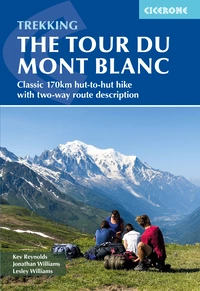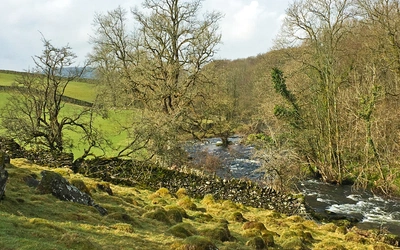How to go long-distance walking with a dog
Bringing your dog with you on a multi-day walking trip need not be as daunting a prospect as you might think. In fact it's a delight, and well worth the additional planning and load carrying you’ll probably need to do.
Our Labrador Cassie has now clocked up the Cotswold Way, the Cumbria Way, the Coast to Coast and the South Downs Way, and feels she has earned her place among canine long-distance walkers.
Owning a dog is a great way to keep having regular exercise, and walking with your dog is one of the best ways to form a strong bond between man and beast. With anything ranging from a quick circuit of the park to a day walk on the fells of the Lake District, most dog owners will consider their job done. But what about if you want to take on a walking trip that will take several days, or even weeks? When it comes to trekking (long-distance walking/hiking), given the option most people will tend to leave the dog at home, rather than wrap their minds around the additional issues associated with accommodating the dog, and all it's needs. But if you are a dog-owner, you just might be missing out on an exceptional opportunity to cement a friendship and bond with your dog that would be hard to achieve in other ways. It just needs a little more planning.
Age and fitness – of the dog!
First, obviously only consider taking your dog on a long-distance walk if it is reasonably young, fit, and either used to long walks, or has had the opportunity to build up fitness and duration of walks for a good few weeks before you go. Never attempt to take a very young dog (under around 18 months to 2 years) on a trek, as they will still be growing and you should avoid stressing the bones, joints and muscle.
Build long walks with the dog into your own pre-trek training, and include a good proportion on rough or hard surfaces, such as concrete, rock and roads, to toughen the dog’s pads. This way you can be confident that your dog will be able to easily manage a long walk day after day.
Overnight accommodation issues
Consider what accommodation you will be using on the way. Camping is one possibility. It’s cheap and provides you with flexibility, but it does add considerably to the weight you will be carrying, especially if you also carry some of the dog’s food. It’s also more difficult if the weather is cold or wet, as a small tent and a wet dog don't tend to make a good combination! Bed and breakfast is the other option, but will need to be carefully planned and booked, as not everyone welcomes tired muddy dogs, or even clean dry ones, so your accommodation options may be much more limited. Having said that, establishments that welcome dogs will often go overboard to make your dog welcome. We’ve stayed in everything from a bunkhouse in Ennerdale to beautiful country house hotels, and Cassie has enjoyed everything from a few dog biscuits to her own cooked breakfast, and has sometimes been provided with a huge comfortable bed to sleep in.
Do make sure that your dog is carefully supervised, so that fellow guests aren’t bothered, so that the establishment is encouraged to continue accepting dogs. Don’t ever allow your dog on beds, even if this is normally allowed at home. Sadly the National Trails accommodation lists do not immediately show you if dogs are welcome, however there are many other websites that we have found useful, as they clearly indicate whether dogs are welcomed. Searching for ‘dog-friendly B&B’, or ‘pet-friendly B&B’, along with the town or region should bring up useful results. Always try to book early, as choices for dogs are more limited. There are some suggested websites listed at the bottom of this article.
Never attempt to take a very young dog (under around 18 months to 2 years) on a trek, as they will still be growing and you should avoid stressing the bones, joints and muscle
Searching for ‘dog-friendly B&B’, or ‘pet-friendly B&B’, along with the town or region should bring up useful results. Searching for ‘dog-friendly B&B’, or ‘pet-friendly B&B’, along with the town or region should bring up useful results.

So what does a dog need?
A kit list can be found at the end of this article, but here is a breakdown of what your dog will need for a trek in the UK.
Food
It's always best to try to give your dog the brand and type of food that they are used to. Some walking routes will pass village shops regularly, allowing you to buy dog food almost on a day by day basis, but you should probably aim to carry some food anyway, in case shops are shut, or your plans have to change.
If you give your dog dry complete food, then weigh out each meal, and pack in separate sealed plastic bags. This will make meal times quick and efficient to administer when you arrive at the end of the day. Plan on giving your dog more food than normal, or switch to a higher energy formula, as your dog will be using many more calories than normal.
You can also use the empty plastic bags to hold a lunchtime snack for the dog – Cassie always appreciates a spare sausage from breakfast, or a bit of bacon!
If you’re on a trek for more than a week, then consider sending a food parcel ahead. Phone a pre-arranged B&B and ask if this is OK. Then check the parcel has arrived safely before setting off, just to be sure.
Water
Keep a good supply of water for your dog, especially in hot weather. Some dogs will only tend to drink two or three times a day, others more frequently. This means it's sometimes a good idea to carry extra water for the dog during the day, but always make sure they are well hydrated at the start and end of each day.
Equipment
Light, collapsible water/food bowl. Fabric ones work very well, they’re very lightweight, and collapse into a small space. Other plastic options are available at varying costs, but are heavier.
Something to sleep on. A bed mat, such as vet bed is comfortable and fairly light, or just a fleecy throw should be fine, although Cassie often manages to avoid lying on her bed at all!
Small towel. You could take a normal towel, or if you have old trekking towels, take one of those. Other options can include cheap, light, highly absorbent car cleaning cloths. Cassie has one – it works well, and washes and dries quickly.
The only other things you need are poo bags and some wet wipes, although we have recently started bringing a length of vet bandage, just in case, as we have the world’s clumsiest lab, and tend to expect trouble. Oh... and a small favourite dog toy is a good idea, as it can be very comforting for your dog when in a strange place night after night.
So, that's a fair bit of extra bulk and weight to take, just when you have managed to get your own kit down to a streamlined lightweight minimum!

You don't have to carry it all yourself though.
Depending on the size of dog, you may feel you can and should carry everything yourself, however with a dog that's on the large side, there's a lot of weight in the food needed, but there's also the option of getting the dog to carry some, or even all of its own gear. Doggy panniers are the answer.
A dog can safely carry up to 20% of its body weight, which for a Labrador means around 5-6kg. In practice Cassie our Labrador has never carried that much. Generally the most she has carried is three days-worth of dried dog food, her bowl, poo bags and her cuddly toy, a total of around 3-3.5kg, including the weight of the panniers. We once tried her with four days-worth of food, and it was noticeable how she tired more quickly. But she loved it, and seemed to think she was doing a great job 'helping'!
Well ahead of the trip, introduce your dog to panniers, maybe borrow some if that’s possible. At first put the panniers on your dog with nothing in the bags, just to wear for a few minutes around the house, and give your dog oodles of praise and encouragement. You can then gradually build up the time using the panniers, out on walks, and then with a small amount of weight. Be warned though, you'll get loads of comments that you're 'cheating by getting the dog to carry it all' but most people, particularly dog owners, will think it’s a great idea, and ask you where you got the panniers!

Some special tips
Take a lead that’s lightweight, and either fairly long (around 1.5m), or slightly elasticated. You won’t always need to keep your dog on a lead, but if you do, and you’re walking single file on a narrow path, it’s easier to have the dog in front of you with enough length in the lead so you’re not tripping over their back legs all the time. Some leads (especially elasticated ones) clip easily to a belt or rucksack, allowing you hands-free control. Don’t use a retractable lead as you’ll curse the extra weight and bulk.
Buy the best panniers you can afford, that are comfortable for the dog, and stay in place.
Our first set of panniers were quite cheap, but weren’t especially robust or waterproof, and tended to droop to one or other side, making it uncomfortable for Cassie to carry. We subsequently invested in Ruffwear ‘Approach’ panniers, which are brilliant. They fit well, look smart and withstand a lot of rough treatment when Cass forgets she has them and squeezes through narrow stiles.
If you have a water-loving dog, or indeed if you’re out in the rain, it’s a good idea to use multiple bags for the dog food being carried by your dog. We have found that the ‘press and seal’ freezer bags work well for each meal/portion of dried dog food, then put each bagged portion in another zip lock bag, then finally put all the food bags in a carrier bag, and tie it down firmly before loading a pannier. This will generally withstand several impromptu swimming sessions!
Keep a few dog treats ready to hand for snack stops. We also find that ordering a cooked breakfast, but saving the sausage, and sometimes the bacon for the dog keeps the calories going in. Just save one of your plastic bags used for dog food and pop the sausage in for later.
On the subject of food and snacks, we have never had this problem, but for those with very deep chested dogs prone to having a twisted gut, one very ‘dog-savvy’ B&B lady suggested that you only feed a very small amount at breakfast time, and most of the daily food at the end of each day to minimize the risk.
Finally, make sure your dog is up to date with vaccinations, wormer and has just had a top-up of ‘Frontline’ or similar, for protection against mites, fleas and ticks.
A cautionary word
Being strongly territorial, you will already know that your dog will have routines and preferences when it comes to toilet needs. These can be challenging, if not well neigh impossible to accommodate when staying at a different location each night. Strange things may happen, and you may find your pet goes to extraordinary lengths to only perform when the circumstances feel exactly right!

Trekking overseas
Although I have no direct experience of trekking with our dog overseas, we have seen one or two dogs on mountain treks in the Alps. You may well find that you have to make considerable compromises on accommodation, as mountain huts do not generally accept dogs inside, although will make provision form your dog to sleep in the dry outside. Private accommodation in villages and gites will vary in their attitude towards dogs, so always check ahead.
Regulations regarding taking a dog to mainland Europe can be found on the Government Pet Travel Scheme website. In essence, your dog must be microchipped before it’s vaccinated against rabies. (The vaccination won’t count for travel if your pet isn’t microchipped first). You can then apply to obtain a passport for your dog. There are also regulations relating to treatment for tapeworm, which must be carried out and recorded in the pet passport before leaving or returning to the UK.
Have a great time trekking with your dog! If you do go away with your dog, then do send us photos, or even an account of how you got on. We hope to build a collection of tips and experiences to share.
Dog kit list
Some of the essentials for your dog.
Essentials:
Food – for as many days as you plan to be away
Small bag of dog treats
Any medication your dog takes regularly
Water/food bowl – lightweight and collapsible
Lead
Poo bags
Wipes
Towel – cheap quick-drying and lightweight
Bed/rug – ditto
Optional extras:
Panniers
Tick remover
A roll of vet bandage
Extra zip lock plastic bags
Dog shampoo
... and a small cuddly toy (ball/other)!
Some accommodation websites
- dogfriendlybritain.co.uk allows you to search by county, and region. Cottages, hotels and B&B all featured.
- theruffguide.co.uk has extensive listings, again with options to select by region.
- bedandbreakfastsearcher.co.uk has good dog-friendly options to make selections, as does britainsfinest.co.uk













